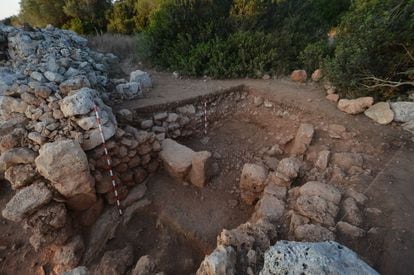During the 3rd century BC. C. the Mediterranean was a sea on fire. Carthaginians and Romans fought during the so-called Punic Wars for control of southern Europe and North Africa. The island of Menorca, an ally of Carthage and located at the center of the conflict, was not alien to this battle. Towards the year 206 a. C., before the imminent arrival of the Roman army, the Carthaginians anchored their powerful fleet in Menorca, re-walled an old Talayotic settlement near the current Ciutadella and endowed it with an unknown military novelty on the island: the elbow door. The study
A new milestone for the study of Punic polyorcetics. Elbow access of Son Catlar
now rebuild that “passive defense” that ended up becoming offensive and that allowed the Roman legions to withstand the challenge.
The Carthaginians and their allies resisted until 123 BC.
C., when General Quinto Cecilio Metelo, nicknamed
Balearic
for being the architect of the conquest of the archipelago, took the settlement and razed part of the fortification, but not before carrying out a propitiatory ritual of which archaeologists have found clues.
More information
Culture will allow the construction of 120 houses in the Roman-Punic site of El Molinete
Fernando Prados, Helena Jiménez, María José León and Joan de Nicolás, from the Universities of Alicante, Murcia, the Museu de Ciutadella and the Institut Menorquí de Estudios, co-directors of the investigation, have reconstructed using a quasi-detective technique, based on the discovery from the gate, how was the settlement of Son Catlar, how its inhabitants defended themselves behind the kilometer of wall that protected them and what was its end. Experts distinguish up to four different phases in the site, which "had its origins at the end of the Bronze Age (9th century BC) and reached its maximum development shortly before the Roman conquest."
The first Menorcan walls were of the "passive" type, which means that "they were prepared to resist specific attacks, but not to counterattack," explains Prados, from the Institute of Archeology of the University of Alicante (INAPH). They were erected with huge blocks that formed cyclopean walls that surrounded or integrated the indigenous talayots. Five of these have been identified in Son Catlar, which makes it the largest known town on the island. These walls hardly had small doors that could be blocked in case of imminent danger. Its bastions were built following techniques and measures compatible with the Carthaginian ones, using the so-called “Punic elbow” (52 centimeters), which was applied by itself or in multiples of three. That is, in military construction,everything measures 52 centimeters by 3, 6, 12… without exception.
But these walls, with the passage of time and the warlike confrontations that followed, changed their structure, “incorporating the technical innovations of an architectural nature that had been successfully developed before in the Mediterranean.
The defense of the community not only implied the effort of construction, but it also assumed that the society that developed it was perfectly coordinated to organize and carry out its function, dividing the tasks ”, the archaeologists comment.
Excavation of the elbow gate of the Son Catlar deposit Modular Project
From the 3rd century BC. C., and due to the advances of the war machine (battering rams, assault towers, sapper corps ...) and siege techniques, these passive defenses will become "active" to counterattack and better resist the sieges. . They will then include bastions to house useful ballistics pieces to deter the approach of the enemies. In fact, the existence of torsion machinery (crossbows and catapults) has been confirmed in Son Catlar with the discovery of projectiles next to the wall and in its surroundings.
Upon excavating the perimeter, the archaeologists found to their surprise "a parapet approximately 1.60 meters wide (three Punic cubits), with a hollow space up to the wall also three cubits long that protected an access". This allowed them to state that they were before an elbow door, similar to those known in other Punic cities or in Carthage itself, the capital of this Mediterranean civilization.
A very short distance from the threshold of this door, inside, an "interesting batch of Roman military elements" was exhumed: lead projectiles that due to their weight can be dated between 200-100 BC. C., as well as several arrowheads and spearheads. A spherical faience setting [glazed pottery], a bronze ring, various coins and surgical items such as a slate paddle for sharpening instruments, a bronze probe-spatula, several iron needles and a bone awl were also found. The latter are typical sanitary materials of the
valetudinaria
, the hospitals of the Roman camps.
Finally, in addition to a stiletto with a spatula to write and erase on wax tablets, an iron knife of about 22 centimeters was unearthed, deliberately placed under a Talayotic stone mill that is associated with the sealing of the door.
"The clearly voluntary gesture of placing the knife on the ground and carefully placing a mill on top could indicate, together with the rest of the objects, the existence of a typically Roman ritual of depreciation [destruction and sealing]," the experts indicate.
Knife found in the Carthaginian site of Son Catlar.Modular Project
One meter from the same door, they have also found “the remains of an individual of a certain age, according to the evidence of visible osteoarthritis, with parts in anatomical connection; the spine and the ribs ”. It was a deliberate deposit, and the place to bury it was well chosen, just outside the door. Carbon 14 tests date it to the “mid-late 3rd century BC. C. ".
The elbow door also had a sentry box to store weapons and for a soldier to stand guard. The access had two gates, one at the beginning of the elbow and one at the end. From the latter the fittings have been found. However, “it was not the main access to the city, rather it was a postern, masked by a parapet to respond to a precise demand: to be able to move without being seen and, by forcing the turn when entering, hinder the passage and avoid its demolition with a ram ”. The main door, through which inhabitants, belongings and food would enter, was to the north, protected by towers. The dates obtained in the excavation lead directly to the Roman-Carthaginian conflict of which the texts of the historian Tito Livio speak.
Ultimately, experts say, this settlement, erected in an elevated area near the sea, from where neighboring Mallorca is perfectly visible, had defensive machines that would force the enemies to move away from their camps, as well as an elbow access that it would allow them to go out unseen to send messages or to get groceries. For this reason, when the Romans took the enclave in 123 BC. C., only left standing the largest of the entrances and razed the small one, executing a magical-religious ritual. The islands were not to use it again ...


/cloudfront-eu-central-1.images.arcpublishing.com/prisa/YAS3TNGA5BE5HP6LPTTHYXGNGQ.jpg)
/cloudfront-eu-central-1.images.arcpublishing.com/prisa/SKTQKMBVVFC57N2EWM4CECDMPA.jpg)








/cloudfront-eu-central-1.images.arcpublishing.com/prisa/S7ERVSCT4FUVX6R7TUVBDNTH5Y.jpg)


